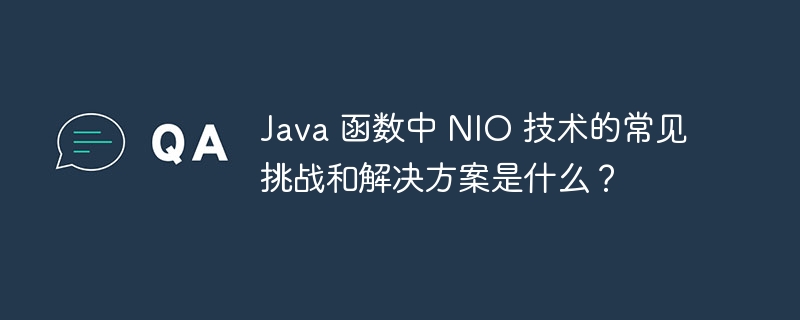Home >Java >javaTutorial >What are the common challenges and solutions for NIO technology in Java functions?
What are the common challenges and solutions for NIO technology in Java functions?
- WBOYWBOYWBOYWBOYWBOYWBOYWBOYWBOYWBOYWBOYWBOYWBOYWBOriginal
- 2024-05-03 14:15:02732browse
Common challenges when using NIO technology in Java functions include: selector polling, buffer overflow, deadlock/starvation, and network outages. Solutions include using a multi-threading/event loop framework, adjusting polling intervals, allocating buffer sizes appropriately, using dynamic buffers, carefully considering lock usage, using timeouts/fair locks, regularly checking channel status, implementing retry mechanisms and circuit breaking device mode. By addressing these challenges, you can take full advantage of NIO technology and build high-performance, scalable Java functions.

Common challenges and solutions for NIO technology in Java functions
Introduction
NIO ( Non-Blocking I/O) technology is an efficient asynchronous I/O mechanism. Using NIO in Java functions can significantly improve application performance. However, there are some common challenges with using NIO.
Challenge 1: Selector Polling
NIO uses the selector polling mechanism to monitor multiple channels. The selector fires an event when the channel is ready for I/O operations. However, polling loops can cause excessive CPU usage, especially if the application handles a large number of concurrent connections.
Solution:
- Use multi-threading or an event loop framework (such as Netty) to handle selector events concurrently.
- Adjust the selector polling interval to reduce unnecessary polling under low load conditions.
Challenge 2: Buffer Overflow
NIO uses buffers to store incoming and outgoing data. If the buffer is too small, a buffer overflow exception may result.
Solution:
- Allocate buffer size reasonably based on expected data size.
- Use dynamic buffers and adjust the buffer size as needed.
Challenge 3: Deadlock and Starvation
The locking mechanism in NIO may cause deadlock and starvation problems. For example, if the same thread holds multiple locks, it may cause other threads to wait for these locks, resulting in a deadlock. Starvation is when some threads never get the lock, while other threads keep getting the lock.
Solution:
- Carefully consider the order in which locks are acquired and released.
- Use timeout mechanism or fair lock algorithm to avoid deadlock and starvation.
Challenge 4: Network Outage
Network outage may cause the NIO channel to close or become unstable. This can cause application anomalies or data loss.
Solution:
- Check the status of the channel regularly.
- Implement a retry mechanism to try again when an I/O operation fails.
- Use circuit breaker pattern to manage frequent errors.
Practical case
Suppose we have a Java function that needs to handle a large number of concurrent HTTP requests. Using NIO technology can significantly improve the performance of this function.
Here's how to solve the above challenges in practice:
- Use the Netty event loop framework to handle requests concurrently.
- Allocate a buffer based on the expected size of the HTTP request.
- Implement fair locking to avoid starvation.
- Regularly check channel status and handle network outages.
By solving these challenges, we can take full advantage of NIO technology and build high-performance, scalable Java functions.
The above is the detailed content of What are the common challenges and solutions for NIO technology in Java functions?. For more information, please follow other related articles on the PHP Chinese website!

